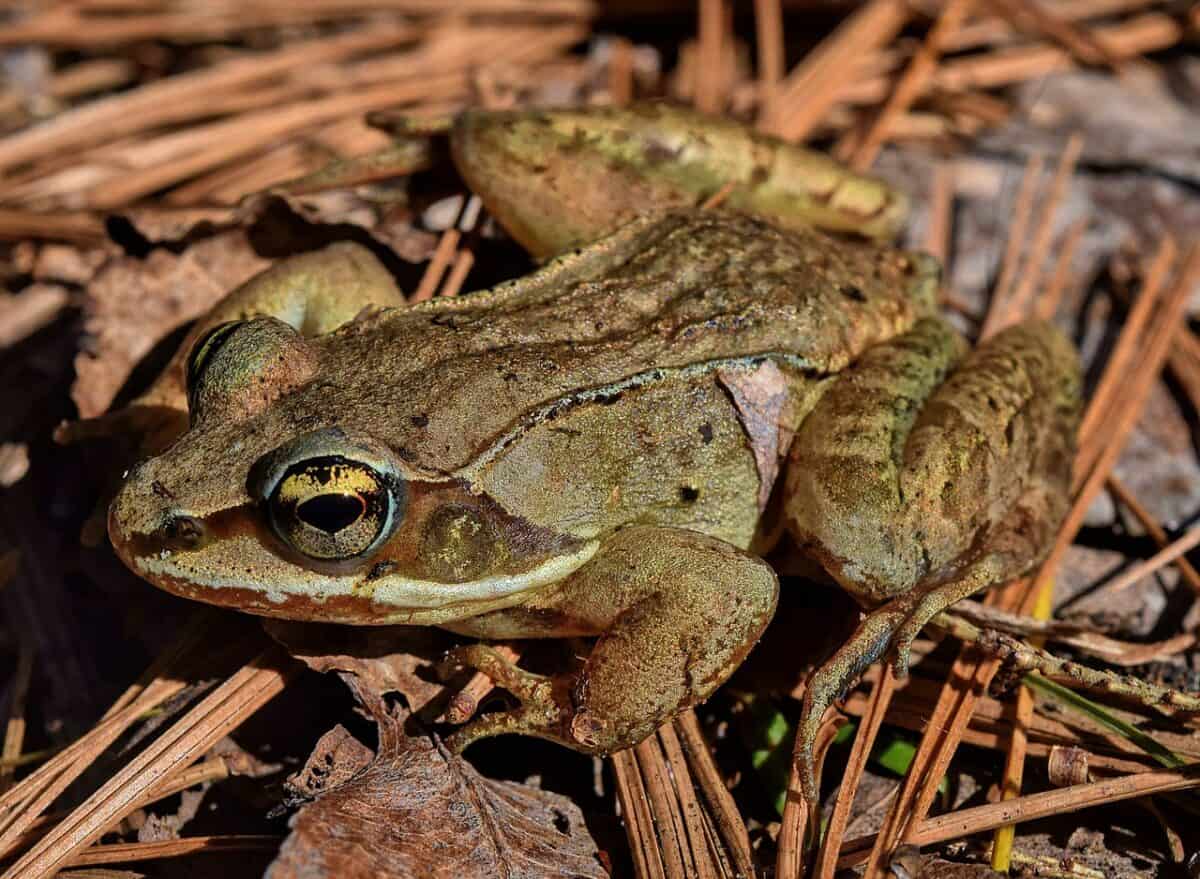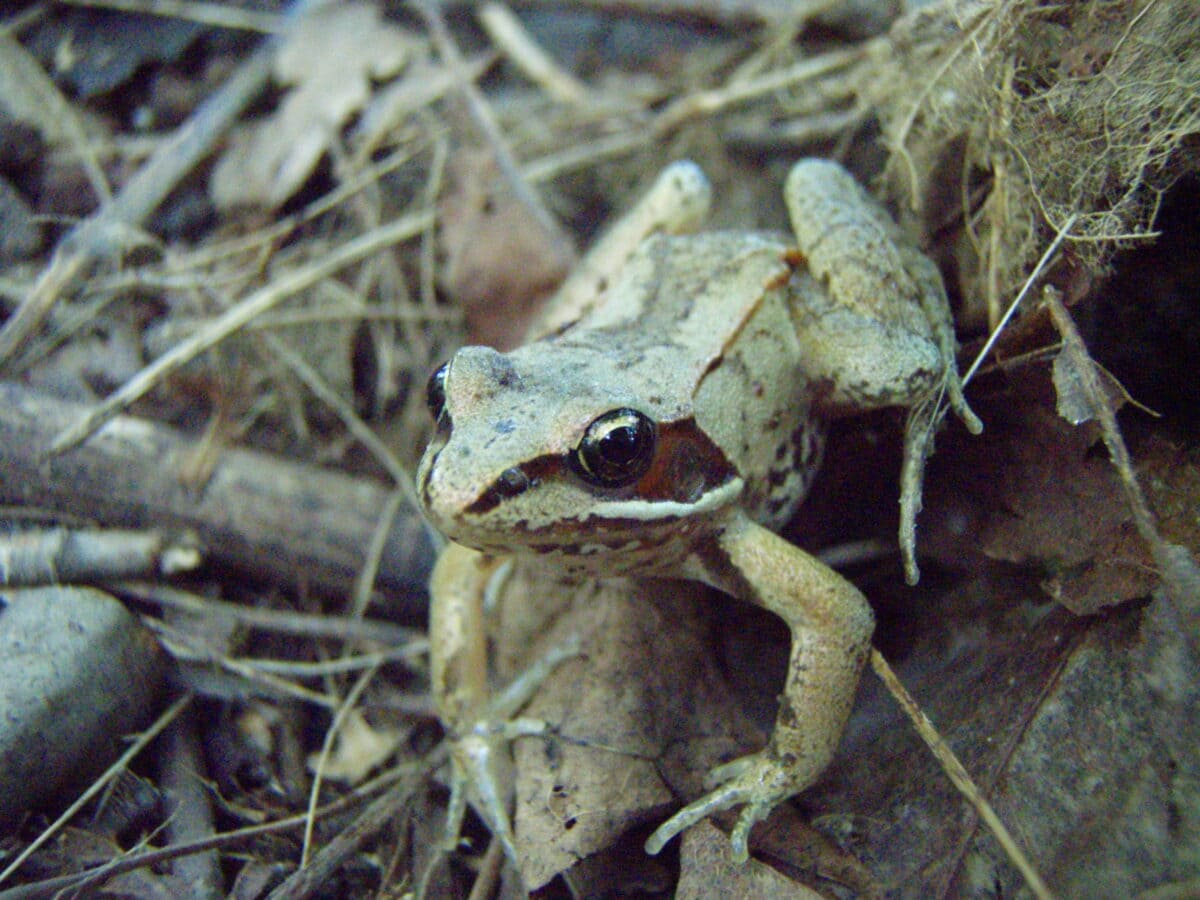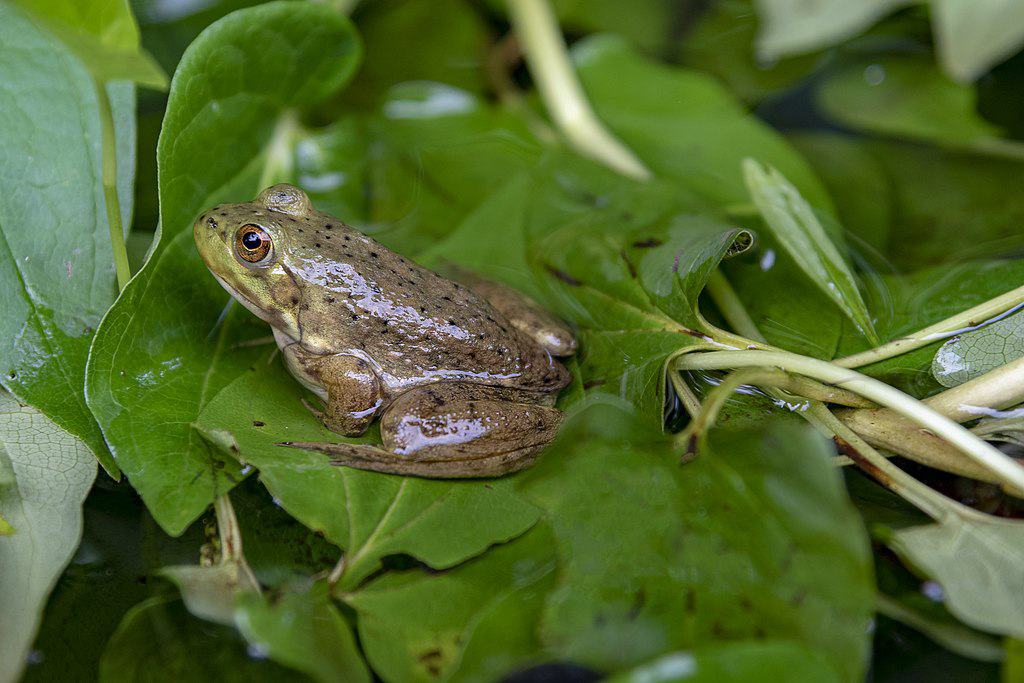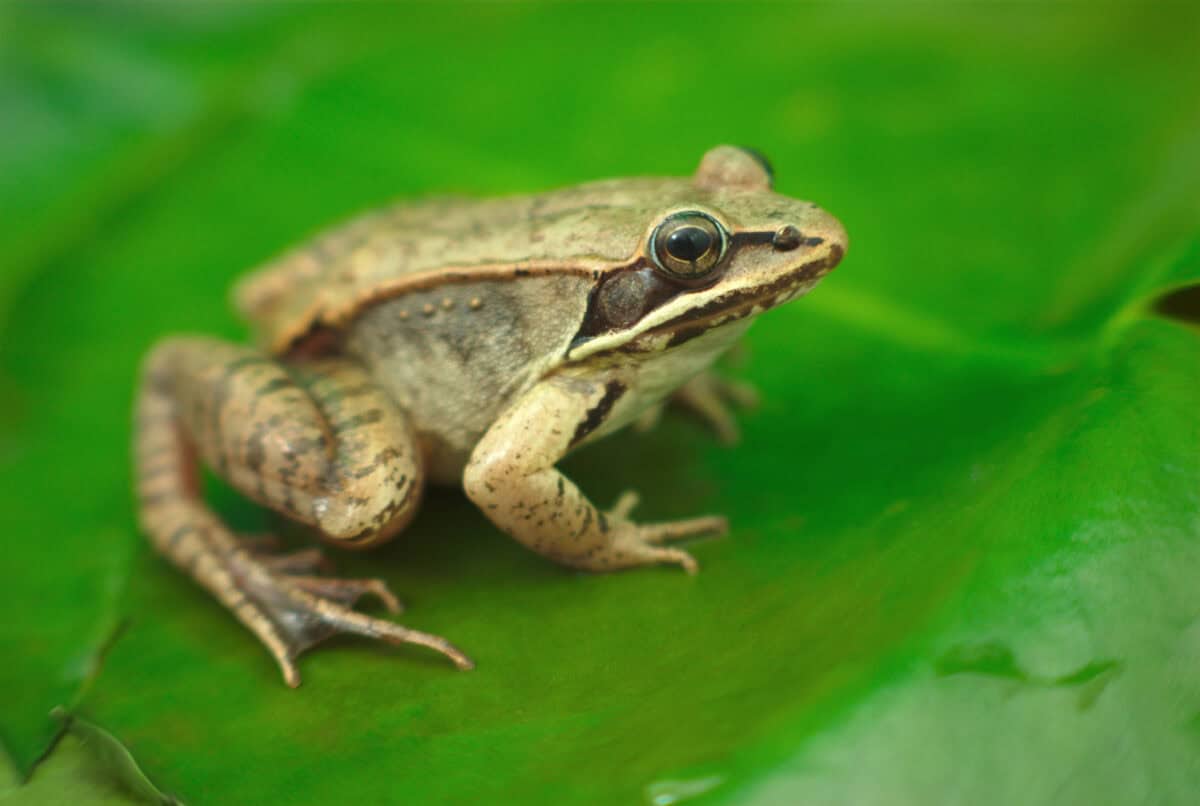In the depths of winter, when temperatures plummet below freezing, most animals migrate or hibernate to survive. However, one remarkable amphibian defies conventional survival strategies with an extraordinary adaptation that borders on the miraculous. The wood frog (Lithobates sylvaticus) possesses the remarkable ability to freeze solid during winter months and thaw back to life when spring arrives.
This freeze-tolerance capability represents one of nature’s most fascinating survival mechanisms, allowing these small creatures to endure conditions that would be fatal to most other vertebrates. As climate change alters seasonal patterns and creates more unpredictable freeze-thaw cycles, understanding this frog’s unique adaptations has become increasingly relevant to both conservation efforts and potential medical applications.
Meet the Wood Frog: Nature’s Cryogenic Marvel

The wood frog (Lithobates sylvaticus) is a relatively small amphibian, typically measuring between 3.5 to 7 centimeters (1.4 to 2.8 inches) in length. With a distinctive dark facial mask resembling a robber’s disguise and a body color ranging from tan to dark brown, these frogs are native to North America, with a range extending from the southern Appalachians to north of the Arctic Circle in Alaska and Canada.
This makes them the most northerly amphibian in North America, venturing further into Arctic regions than any other reptile or amphibian. Their remarkable cold tolerance has enabled them to inhabit regions where winter temperatures regularly drop well below freezing for extended periods, environments that would be uninhabitable for most amphibians.
The Freezing Process: A Biological Miracle

When autumn transitions to winter and temperatures begin to drop, the wood frog initiates a remarkable physiological transformation. Rather than migrating to warmer regions or finding deep underwater hibernation spots like many other amphibians, wood frogs prepare for freezing. As temperatures fall below 0°C (32°F), ice crystals begin forming on the frog’s skin. These crystals serve as nucleation points, triggering the freezing of water throughout the frog’s body.
During this process, up to 65-70% of the total body water freezes solid. The heart stops beating, blood flow ceases, and breathing halts completely. For all practical purposes, the frog appears dead—its eyes white and cloudy, its body hard and unresponsive, essentially transformed into a frog-shaped ice cube. This state of suspended animation can last for weeks or even months, depending on environmental conditions.
Nature’s Antifreeze: Glucose and Urea Protection

The wood frog’s survival during freezing depends on a sophisticated biochemical strategy centered around cryoprotectants—natural antifreeze compounds that protect cells from ice damage. As freezing begins, the frog’s liver rapidly converts stored glycogen into glucose, flooding the bloodstream and tissues with this sugar. Within just a few hours, blood glucose levels skyrocket to approximately 50 times their normal concentration.
Additionally, the frog accumulates high levels of urea in its tissues. Together, these compounds act as natural antifreeze, preventing the formation of ice crystals inside cells—a phenomenon that would otherwise rupture cell membranes and cause fatal damage. Instead, ice forms in the spaces between cells and organs, while the cells themselves remain unfrozen due to their high solute concentration. This precise balance allows tissues to survive despite the majority of the frog’s body water transforming into ice.
Cellular Survival Strategies During Freezing

Beyond glucose and urea production, wood frogs employ additional cellular mechanisms to enhance freeze tolerance. As freezing progresses, cells undergo controlled dehydration, expelling water to prevent intracellular ice formation. This cellular shrinkage is manageable thanks to specialized proteins that maintain cell membrane integrity despite significant volume changes.
Additionally, wood frogs produce antifreeze proteins (AFPs) and ice-nucleating proteins (INPs) that control where and how ice crystals form, directing ice growth to locations where it causes minimal damage. The frogs also upregulate the production of chaperone proteins and antioxidants that protect cellular components from cold-induced damage and oxidative stress. These multifaceted adaptations work in concert to preserve cellular structure and function during extended periods in a frozen state.
The Remarkable Thawing Process

Perhaps even more astonishing than the freezing process is the wood frog’s ability to thaw and resume normal biological functions. As spring temperatures rise, the ice within and surrounding the frog’s tissues gradually melts. Remarkably, the heart is among the first organs to revive, beginning to beat even while the frog remains partially frozen. Within 8-12 hours of thawing, the circulatory system restarts, delivering oxygen and glucose to oxygen-starved tissues.
Within 24 hours, most frogs recover sufficient muscular coordination to hop, albeit somewhat clumsily. After approximately 48 hours, the frog typically exhibits complete behavioral recovery, with no apparent permanent damage from its frozen state. This rapid return to normal physiological function represents one of the most remarkable recovery processes known in vertebrate biology.
Multiple Freeze-Thaw Cycles: Testing Survival Limits

In laboratory settings, researchers have demonstrated that wood frogs can endure multiple freeze-thaw cycles within a single winter season. Field studies confirm this occurs naturally as well, with frogs experiencing as many as 7-10 freeze-thaw cycles during unpredictable spring and fall weather. Each cycle subjects the frog’s body to significant physiological stress, depleting energy reserves and potentially causing cumulative damage. However, wood frogs have evolved to manage these challenges, replenishing glucose levels and repairing cellular damage between freezing events.
This ability becomes increasingly important as climate change creates more variable winter conditions with frequent temperature fluctuations. There are limits, however—repeated cycles without sufficient recovery time between them can exhaust the frog’s energy stores and compromise survival. Scientists are actively studying how climate change-induced weather pattern alterations might affect wood frog populations over time.
Geographic Variations in Freeze Tolerance

Wood frogs exhibit geographic variation in freeze tolerance capabilities, with populations adapted to their local climate conditions. Frogs from Alaska and northern Canada demonstrate superior freeze tolerance compared to their southern counterparts, capable of surviving lower temperatures and longer freezing durations. This variation results from both genetic adaptations and phenotypic plasticity.
Northern populations maintain larger glycogen reserves in the liver, produce higher glucose concentrations during freezing, and possess cellular membranes with different phospholipid compositions that maintain fluidity at lower temperatures. These differences highlight the species’ evolutionary adaptability and suggest that freeze tolerance capabilities have evolved multiple times in response to local environmental pressures. Such variations help scientists understand how climate and geography shape physiological adaptations and may provide insights into potential climate change responses.
Other Freeze-Tolerant Amphibians and Comparisons

While the wood frog is the most well-studied freeze-tolerant amphibian, it’s not the only species with this capability. Several other North American frogs, including spring peepers (Pseudacris crucifer), chorus frogs (Pseudacris triseriata), and gray treefrogs (Hyla versicolor), also exhibit varying degrees of freeze tolerance. Outside North America, the European common frog (Rana temporaria) and some Asian species display limited freeze tolerance. However, none match the wood frog’s extreme capacity for prolonged freezing at low temperatures.
In contrast, many reptiles and amphibians employ supercooling—lowering body temperature below freezing without ice formation—or antifreeze production without actual freezing. The wood frog’s approach represents the most extreme vertebrate freeze tolerance adaptation documented to date, making it uniquely valuable for comparative physiological studies and biomimetic applications.
Medical and Technological Applications

The wood frog’s extraordinary freeze tolerance mechanisms have captured the attention of medical researchers and bioengineers seeking to improve organ preservation techniques for transplantation. Current methods allow human organs to remain viable outside the body for relatively short periods—typically hours rather than days—severely limiting transplantation logistics. Researchers are studying wood frog cryoprotectants and cellular adaptations to develop improved preservation solutions that could extend organ viability.
Additionally, scientists are investigating applications in blood storage, cell line preservation, and the development of synthetic antifreeze compounds based on wood frog biochemistry. Some researchers are even exploring whether similar mechanisms could eventually contribute to human tissue cryopreservation technologies. While practical applications remain in developmental stages, the wood frog’s natural freeze tolerance continues to inspire biomimetic innovations in medical and biotechnological fields.
Conservation Challenges and Climate Change

Despite their remarkable cold adaptations, wood frogs face numerous conservation challenges. Habitat loss from urban development, forestry practices, and wetland drainage threatens breeding sites and upland forest habitats essential for their life cycle. Additionally, emerging amphibian diseases, particularly chytrid fungus infections, pose significant risks to populations. Perhaps most concerning is climate change, which creates increasingly unpredictable winter conditions.
More frequent freeze-thaw cycles without sufficient recovery periods between them may exceed the frogs’ physiological capabilities. Earlier spring thaws can disrupt breeding timing, potentially desynchronizing reproduction from optimal environmental conditions. Conservation efforts focus on habitat protection, maintaining connectivity between breeding ponds and upland forest habitats, and monitoring population responses to changing climate patterns to identify vulnerable populations requiring intervention.
Reproductive Strategy and Life Cycle Adaptations

Wood frogs have evolved a reproductive strategy perfectly synchronized with their freeze tolerance capabilities. They are among the earliest amphibians to breed in spring, often gathering at vernal pools while ice still partially covers the water surface and nighttime temperatures may still drop below freezing. This early breeding provides tadpoles with a competitive advantage—longer development time before pools dry in summer and reduced predation pressure from insects and other predators not yet active.
The wood frog’s entire life cycle reflects adaptations to northern climates. Eggs develop rapidly in cold water, tadpoles metamorphose quickly (typically within 6-15 weeks), and juvenile frogs must accumulate sufficient energy reserves during a short summer to survive winter freezing. This accelerated life history, combined with freeze tolerance, allows wood frogs to thrive in environments with short growing seasons and long, harsh winters—ecological niches unavailable to most other amphibians.
Research History and Scientific Discoveries

Scientific investigation into wood frog freeze tolerance began in earnest in the 1980s, pioneered by Dr. Kenneth Storey and colleagues at Carleton University in Canada. Their groundbreaking research identified glucose as the primary cryoprotectant and described the basic physiological mechanisms allowing survival during freezing. Subsequent decades have seen increasingly sophisticated analyses using genomic, proteomic, and metabolomic approaches to understand the molecular underpinnings of freeze tolerance.
Key discoveries include the identification of specialized ice-nucleating proteins, the roles of specific gene expression patterns during freezing and thawing, and the importance of anoxia tolerance mechanisms that protect tissues during oxygen deprivation. Each research advancement has revealed additional layers of complexity in this remarkable adaptation. Current research focuses on epigenetic regulation during freezing, the roles of small non-coding RNAs in controlling freeze response, and potential applications of these findings to human medicine and biotechnology.
The Evolutionary Marvel of Freeze Tolerance

The wood frog’s freeze tolerance capability represents one of nature’s most remarkable evolutionary adaptations. This extraordinary survival strategy didn’t develop overnight but emerged gradually through natural selection over thousands of generations. The evolutionary pathway likely began with cold hardiness adaptations that progressively enhanced glucose response to cold stress, followed by refinements in cell membrane composition, protein protection mechanisms, and controlled ice formation.
The ability to survive freezing provided wood frogs with exclusive access to northern habitats and early breeding opportunities unavailable to freeze-intolerant competitors. This survival strategy demonstrates the incredible adaptability of life and nature’s capacity to find solutions to seemingly insurmountable environmental challenges. By essentially shutting down and restarting life processes seasonally, wood frogs challenge our understanding of the boundaries between life and death and highlight the remarkable diversity of survival strategies that have evolved in the natural world.
- This Fish Has the Most Teeth in the Ocean—And Uses Them Well - August 9, 2025
- How Wolves Use Group Howls to Reunite With Pups - August 9, 2025
- 12 Dog Breeds That Form the Deepest Emotional Bonds with Their Owners - August 9, 2025

